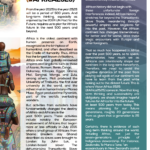By Nsah Mala
This is the inaugural edition of a newspaper called The Ijim Times. Some may wonder where this beautiful, unique name comes from and why its choice.
There is no better time than now to add a new voice to the print and digital media landscape in Cameroon and the world with inspiration from the unique Ijim Mountain Forests. As I will demonstrate, Ijim is a very fitting source of a name for a media organ anchored on brave journalism with a green touch.
The Ijim Mountain Forests are shared between the indigenous kingdoms (fondoms) of Ajung, Kom, Mbessa (Mbesa), and Oku, all found in the Anglophone Northwest Region of Cameroon.
Forming part of the Bamenda Highlands, Ijim Mountain Forests are close to Mount Oku and its surrounding Kilum Forests. In passing, Mount Oku is the second highest mountain in mainland Central Africa, coming after Mount Fako, in Buea, in the Anglophone Southwest Region of Cameroon.
Both Ijim and Kilum Mountain Forests constitute an area of extensive land with rare biodiversity, ranging from tropical rainforests to lake biomes. According to some scholars, Mount Oku and the Ijim Ridge form one of a handful of key sites for afromontane and subalpine vegetation outside of East Africa.
In terms of environmental management, both Ijim and Kilum have been handed over to the local indigenous communities to manage, sustain and preserve for present and future generations.
Understandably, the Ijim Mountain Forests are the main source of inspiration for this newspaper’s name – The Ijim Times. And this can be explained by many reasons. To begin, Ijim Mountain Forests are symbols of both uniqueness and vulnerability in our epoch of global climate change and environmental degradation. We live in the Anthropocene era, a geological period when human activities have caused significant changes on the climate and ecosystems of the Earth.
Meanwhile, Ijim is widely known for the African cherry tree or Prunus africana (called sola in Mbessa) with its priced barks used in treating prostate cancer. Ijim is also popular for having the largest proportion of the Bannerman’s Turaco or Tauraco bannermani (known as ingeng in Mbessa), a bird which is endemic to the Bamenda Highlands in the Western Grassfields of Cameroon.

Caption: Bannerman’s Turaco
Bannerman’s Turaco is extremely beautiful and culturally valuable. It has a diagnostic red crest and colourful plumage. Little wonder that our logo is based on this emblematic and stunning bird! Bannerman’s Turaco has a heavy, powerful and yellow bill with a dark red culmen and exposed nostrils. It has a grey head, orange-red crown, red crest and gray cheeks, dark green upper parts, paler green underparts and a blue, long tail. This bird is shy and difficult to spot. Its voice is distinctive, consisting of a raucous series of “kow-kow-kow” notes that can be heard a kilometre away. When flying, Bannerman’s Turaco explodes from the canopy, showing distinctive deep red panels in its wings.
In addition to its spectacular beauty, Bannerman’s Turaco has a deep cultural value for the people in the Cameroon grassfields. Indeed, the red feathers from Bannerman’s Turaco are used in decorating people in most indigenous kingdoms in Cameroon’s Western Grassfields. This includes the decoration of royal pages (nchindas), manjong and mfuh leaders, among others.

Caption: First sketch of our logo
Unfortunately, this unique, stunning and culturally-important bird has come under serious threats. Bannerman’s Turaco is critically endangered and classified under the Red List of Threatened Species by the International Union for the Conservation of Nature (IUCN). This bird could disappear completely if the forests in which it lives disappear. Its numbers, currently estimated to be 1,500, are plummeting due to habitat destruction and the ancient tradition of hunting the birds for their red feathers. Meanwhile, Kilum and Ijim Mountain Forests, approximately 20,000 square kilometers, are some of the last remaining homes of the endemic Bannerman’s Turaco bird.
I am acutely aware of the numerous environmental and cultural threats faced by sacred and royal animals such as Bannerman’s Turaco in the Bamenda grassfields. The other sacred and royal animals include elephants, wild cats (cheetahs, leopards, tigers, etc.), porcupines, cowries, and so forth. Furthermore, I am equally aware of the enormous importance of the Congo Basin tropical rainforests and the threats to their biodiversity, ecosystems and people. My prize-winning PhD was based on the Congo Basin.
Due to this awareness, I organised participatory foresight and futures thinking workshops on #CongoBasinFutures and #RoyalAnimalsFutures in Yaoundé on 7 September 2024. The workshops brought together a wide range of young and old participants, including, among others, farmers, teachers, students, musicians, filmmakers, writers, environmentalists, security personnel, and indigenous kings (fons). In the workshops we explored ways to protect sacred and royal animals in Cameroon and beyond. The resulting insights and recommendations are forthcoming.
Back to the Ijim Mountain Forests. Beyond Bannerman’s Turaco and Prunus africana, Ijim is also unique for its white honey and fresh water in addition to its ecosystem services and non-timber forest products like bamboos, mushrooms, and raspberries, among others. Ijim Mountain Forests are absorbing greenhouse gases and providing us with feathers, food, medicines, water, wood, and so forth. Sadly, Ijim is very fragile and vulnerable, particularly threatened by bushfires, deforestation, human encroachment, and climate change. Indeed, Ijim is as threatened as its emblematic Bannerman’s Turaco!
However, the calmness and freshness of Ijim, the diversities it harbours, and its numerous ecosystem services and its simultaneous fragility and vulnerability capture the very state of shared Earth today in the Anthropocene. Our Earth is at a crossroads of multiple crises, which some even call polycrisis.
In response to these multiple challenges or crises, the United Nations has adopted frameworks such as the Pact for the Future and the Sustainable Development Goals (SDGs). Disappointingly, Cameroon is barely struggling to leverage unique factors and landscapes such as the Congo Basin and the Ijim Mountain to achieve the SDGs.
The 2025 SDG Report ranks Cameroon at 133 out of 167 countries with available data. So far, Cameroon has achieved only two of these goals: SDG 13 (Climate Action) and SDGS 12 (Responsible Consumption and Production). And this is mainly thanks to our natural ecosystems and the fact that we produce less greenhouse gases in all we do. The 2023 UNESCO Country Profile for Cameroon on Climate Change Communication and Education, which I reviewed as an expert, also demonstrated that much still remains to be done. Accordingly, we must rise up! And this where and why The Ijim Times steps in.
But The Ijim Times does not only take its name from Ijim Mountain Forests. In the Mbessa (Mbesa) language, ijim can also mean all or united. For example, when we say ghela ajim, we mean all people. And when we say Mbessa ijim, we mean all of Mbessa, or the entire Mbessa. This can also mean a united Mbessa. And we can extrapolate this to a united Cameroon, a united Africa, and a united Earth or World. Entanglement and Unity.
The Ijim Times is therefore born as a newspaper that pursues an Earth-anchored approach to journalism in a spirit of living-together among humans and nonhumans. We seek to practice journalism that contributes to solutions on a degrading Earth and in a burning world filled with polarisation and dwindling opportunities.
Remember that Ijim – like the Earth – is a place and symbol of reciprocal generosity. When we care for the Earth and Ijim, we reap bountifully. In the same manner, we expect the Cameroonian and world societies to care for us by providing newsworthy events and collaborations while we reciprocate by writing stories that heal and unite and sharing opportunities for mutual growth. Therefore, one of the hallmarks of this newspaper will be sharing authentic and verified opportunities such as scholarships, fellowships, grants, jobs, and conferences, among others.
Before I conclude, I will emphasise our Earth-anchored approach to journalistic truth. Remember that our slogan presents The Ijim Times as a newspaper for brave journalism with a green touch. To maintain a green Cameroon and world, we shall seek and tell the truth, knowing that to some the truth can be as sweet as the famous Ijim white honey, and to others the truth can be as uncomfortable as the nocturnal coldness of Ijim.
Sometimes the truth may meandre like the meandering streams in Ijim called ngeingeinse in Mbessa. Even when the truth meandres like this, we shall still go for it. Moreover, the meandering streams in Ijim could symbolise the entanglements of the worlds of humans and nonhumans.
Overall, in a spirit of entanglement, unity and living-together, from local through national to global levels, we shall cover news from all domains of life, and share opportunities, while maintaining a predilection for climate, environmental, and sustainable information for present and future generations. On this note, I warmly welcome you all to The Ijim Times!
– Dr Nsah Mala (born Kenneth Kenneth), Publisher, The Ijim Times
First published in The Ijim Times No. 001 on 30 June 2025.








